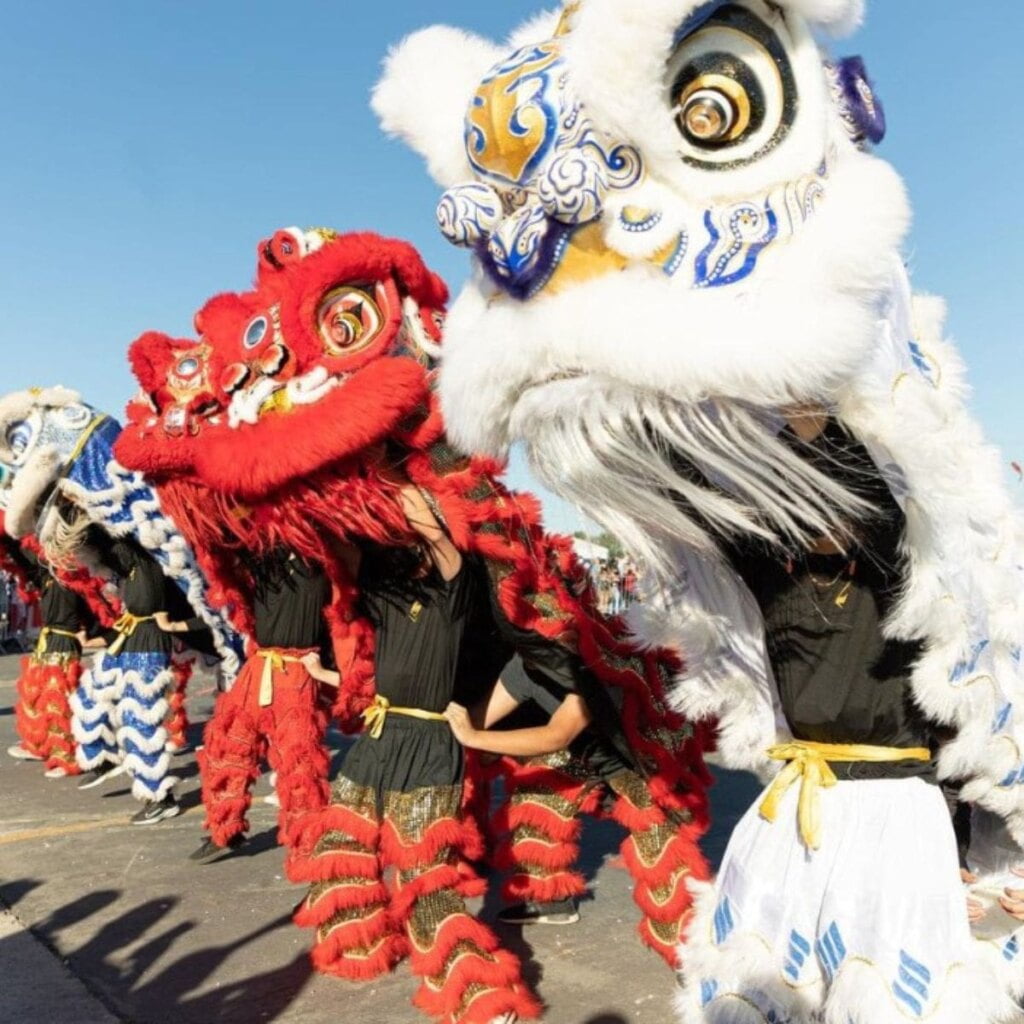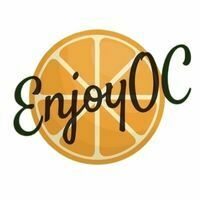The UVSA Tết Festival (Hội Tết Sinh Viên) will ring in the Year of the Dragon with a celebration from February 9-11, 2024 at the OC Fair and Event Center. This Tết festival is the biggest Vietnamese Lunar New Year Festival in the United States.
Tết is short for Tết Nguyên Đán. Considered the most important holiday in Vietnamese culture, Tết celebrates the arrival of a new spring for families to reunite and reconnect, forget the previous years struggles and move forward to a better upcoming year.
Be sure to check out all Orange County Lunar New Year events.

UVSA Tết Festival (Hội Tết Sinh Viên)
Facebook | Instagram | YouTube
Where: Orange County Fair & Event Center
Address: 88 Fair Dr, Costa Mesa, CA 92626
Date/Times
Friday, February 9, 2024 | 4:00PM – 10:00PM
Saturday, February 10, 2024 | 11:00AM – 10:00PM
Sunday, February 11, 2024 | 11:00AM – 9:00PM
Activity Times
Raising of the Bamboo | Friday, February 9 at 5:00pm
Ancestral Altar Procession | Saturday, February 10 at 1:00pm
Spring Wedding | Sunday, February 11 at 1:30pm
Tickets & Admission
Ticket booths are located near the main entrance. Cash and credit cards are accepted. Promotional codes, online discounts, printed flyers, newspaper ads, are not valid at the gate. All sales are final and there are no refunds.
Admission: General Admission is $8 per person. Admission is free for kids 2 and under.
Saturday, February 10 Admission Special: Free admission for visitors wearing traditional Vietnamese clothing (no religious outfits), military, and scout uniforms (no costumes). Valid only on Saturday from 12PM to 1PM.
Things to do at the USVA Têt Festival
There are many activities and events that take place at the festival, including:
- Enjoy traditional Vietnamese food and drink: Têt is a great time to try traditional Vietnamese dishes such as Bánh Chưng, a rice cake made with mung bean and fatty pork fillings packed neatly inside lá dong or green banana leaves. You can also try various types of tea, coffee, and other beverages.
- Watch traditional Vietnamese dance performances: The event features traditional Vietnamese dance performances including lion dances, which are a great way to learn about the country’s culture and history.
- Check out the cultural village: The cultural exhibit features traditional Vietnamese artifacts, clothing, galleries, and traditional Vietnamese architecture. There are many photo opportunities with traditional Vietnamese themes.
- Shop for traditional Vietnamese crafts and souvenirs: Shop for traditional Vietnamese crafts and souvenirs, such as lacquerware, silk clothing, and ceramics
- Multiple Stages: The festival has multiple stages where activities such a pho eating contest, pageants, karaoke, dance performances and more are held. The schedule has back to back performances so there is always something to catch.
- Activities: There are numerous activities for all ages and backgrounds.
- Miss Vietnam of Southern California Pageant: The pageant showcases the contestants’ talents with the yearly tradition of having the pageant at Tết Festival.
Opening Ceremony Special
VALID ONLY on Saturday, February 10 from 12PM to 1PM. Free admission for guests wearing traditional outfits (no religious outfits), military, and scout uniforms (no costumes).
Cultural Village
Also known as Làng Việt Nam in Vietnamese, the Cultural Village is a replica of a traditional village in Việt Nam. Visit the Village to see cultural exhibits, galleries, and models of Vietnamese architecture.
Raising of the Bamboo – Lễ Dựng Nêu
Kick off the festival with the raising of the bamboo, marking the beginning of Tềt. In The Village, see the raising of Cây Nêu (a tall piece of bamboo with a good luck message on a red scroll and firecrackers). This is identical to traditional ceremonies seen throughout Việt Nam today. According to Vietnamese legends, the red color and the bamboo ward off the evil spirits during the absence of the Kitchen Gods, Ông Táo who leave their family to visit the palace of the Jade Emperor. Each Village chooses a Village Deity (Thanh Hoàng) during the Lunar New Year – usually a person of high respect and, often who has done something to positively impact the village or the country.
Ancestral Procession – Lễ Rước Kiệu Tổ
The Têt Festival officially begins with the Ancestral Procession (Lé Ruöc Kieu Tổ). This traditional ceremony features costumed Kings, Queens, Court Officials, soldiers, elders, and ordinary villagers walking in a cultural procession. Participants carry the altar of the Vietnamese founder, King Hùng and offerings to the prayer site (main ceremonial altar) on the Tết Festival stage.
Spring Wedding – Đám Cưới Đầu Xuân
A traditional Spring Wedding kicks off the new year. This traditional wedding ceremony with a real bride and groom includes traditional tea offerings to elders, lion dances, a wedding procession, and a roasted pig!
𝗩𝗶𝗲𝘁𝗻𝗮𝗺𝗲𝘀𝗲 𝗧𝗿𝗮𝗱𝗶𝘁𝗶𝗼𝗻𝗮𝗹 𝗗𝗮𝗻𝗰𝗲𝘀
- Lion dance (múa lân) is typically performed to celebrate special occasions such as Lunar New Year as a means to bring in good fortune. Performers don a lion costume and dance along to drums, cymbals, and gongs.
- The fan dance (vũ phiến) can be performed with small wooden fans or larger, flowing silk fans. Performers dance cohesively as a group to create imagery that evokes gracefulness and beauty.
- The hat dance (múa nón) utilizes Vietnamese leaf hats to, like fan dance, display gracefulness. This dance honors the hardworking farmers and celebrates common everyday life.
Traditional Clothing
The UVSA Têt Festival showcases Vietnamese culture through the traditional clothing, the ao dai. The ao dai is a symbol of cultural identity and Vietnamese heritage and is often associated with grace, elegance, and traditional values.
It is worn by both men and women. For women, it is often seen as a symbol of Vietnamese femininity, and is worn on special occasions, such as weddings and formal events. In addition to its cultural and historical significance, the ao dai is also considered a fashion statement, with many wearing it as a fashionable and stylish garment.
Têt Festival Food
The Vietnamese saying “ăn Tết”, literally meaning “eat Tết”. The Têt Festival showcases unique Vietnamese foods that you should try in time for Tết.
Every year they feature more food from local establishments that are looking to share their culinary vision. A festival wouldn’t be complete without tons of delicious food, make sure you don’t miss out on some great food and great times!
About the Festival Food
When asked what iconic dish comes to mind when talking about Tết, Bánh Chưng is usually the first answer. Bánh Chưng is a rice cake made with mung bean and fatty pork fillings packed neatly inside lá dong or green banana leaves (also known as lá chuối). Its square shape symbolizes the ground expressing gratitude to their ancestors and the earth, as ancient Vietnamese people believed the sky is round and the earth is square.
Making Bánh Chưng is time consuming and requires the assistance of several people, thus making it a special chance for Vietnamese people to gather with their families to make Bánh Chưng and tell each other stories about Tet.
“If Bánh Chưng represents the earth, Bánh Giầy is the sky.”
Together, Bánh Chưng and Bánh Giầy are served during Tết as a symbol for harmony between earth and heaven. It is a tradition to seek balance and prosperity for the new year, as well as showing gratitude to ancestors and those around you.
Bánh Giầy is a flat and round glutinous rice cake, wrapped in cut pieces of banana leaves. It’s served with a type of Vietnamese sausage called “chả lụa”. Bánh Giầy’s round shape is a perfect representation for the sky, as ancient Vietnamese people believed the sky is round and the earth is square.
The meaning of Bánh Chưng and Bánh Giầy comes from the Vietnamese’s Legend of the Rice Cake (Sự Tích Bánh Chưng và Bánh Giầy). Since then, they have become an indispensable part of our Vietnamese culture and for Tết.
The color Red represents good fortune, success and happiness in Vietnamese culture. To embrace these qualities, the traditional Vietnamese Red Sticky Rice Xôi Gấc is often served during Tết. It is a simple dish with two main ingredients – glutinous rice and Gấc. The unique bright red color of the dish comes from the fruit “Gấc”, also known as baby jackfruit or sweet gourd.
The process of making Xôi Gấc is quite ‘chilling’ because of the redness coming from the pulp inside of Gấc. After removing the seeds, the meat of the fruit will be mixed with rice. Coconut milk and sugar are added to enrich the deliciously sweet flavor of Xôi Gấc.
Xôi Gấc plays an important role in the Vietnamese culture as it is a dish believed to bring good luck and fortune.
The five-fruit tray or 𝘮𝘢̂𝘮 𝘯𝘨𝘶̃ 𝘲𝘶𝘢̉ is an essential part of Tết celebrations. You’ll find them on altars as offerings to ancestors or as decorations in living rooms for good fortune. The types of fruit differ from region to region in Vietnam, and each fruit is carefully picked to symbolize a wish for the coming year.
Here is a look at common fruits and their meanings:
- Banana: protection
- Coconut: moderation and balance
- Mandarin: success
- Mango: spending
- Peach: hope
- Watermelon: fertility
Be sure to stop by the UVSA Tết Festival with your family and eat Bánh Chưng!
Related Articles
| Lunar New Year Events In OC | OC Lantern Festival At Segerstrom |
| OC Cherry Blossom Festival | OC Tet Festival At Mile Square Park |
| OC Moon Festival | Where To Buy Lunar New Year Decorations |

